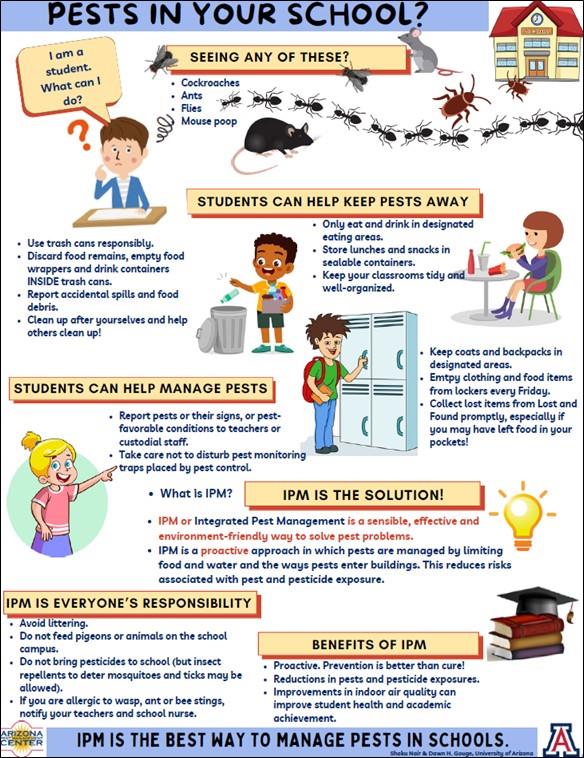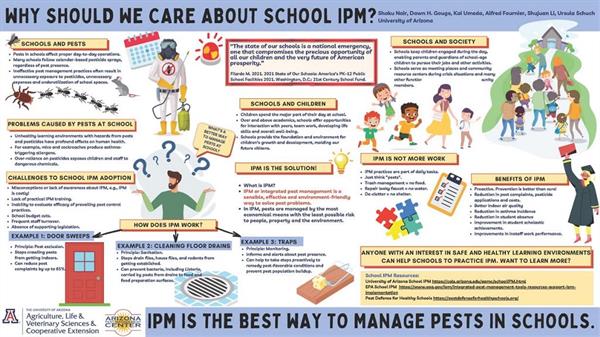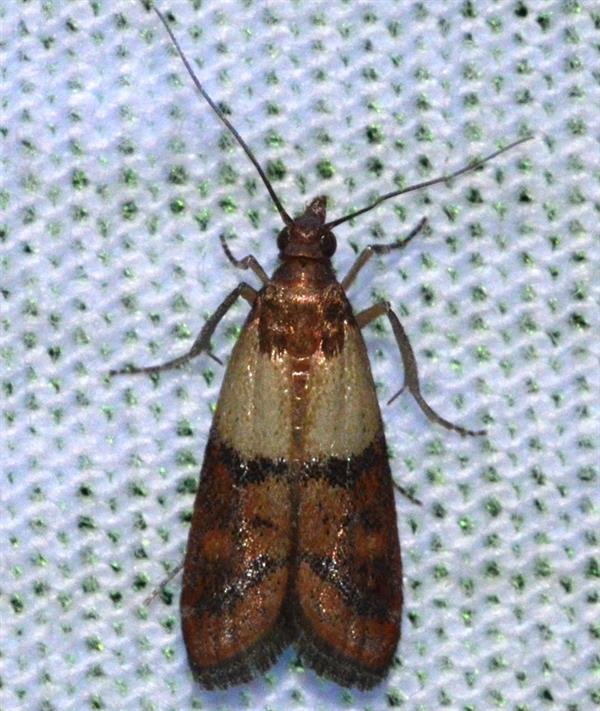
We wish our readers a Happy New Year 2024!

Please take this short 5-question survey about our newsletter:
https://uarizona.co1.qualtrics.com/jfe/form/SV_cMhZ82JodDKJgCa
Shaku Nair and Dawn H. Gouge
Department of Entomology, University of Arizona
The beginning of a new year is a great time to start an IPM program. And what better way than to get students involved and give them an early introduction to IPM? Schools are great places to introduce students to the concepts of IPM. Lessons learned at a young age will remain with them for life. Schools present different environments in which students can observe pests and the problems caused by them, and participate in proactively managing them, while appreciating that not all creatures are pests. Proper identification helps to determine what, if anything, needs to be done. Students are curious, and younger students tend to be less fearful of insects and arachnids! In fact, children often notice insects and other pests or their signs quicker than adults, but in most cases don’t know what to do about them. Students can be great allies in a school IPM program.
Why School IPM?
Children spend the majority of their awake life in schools, as do many adults (teachers and other staff, parents). Most schools at some point or another face pest problems that affect their proper functioning. Pest management contracts that rely on routine scheduled pesticide treatments regardless of the need have not proven effective at preventing these occurrences, and while many of the calendar-based treatments are intended to keep the school environment pest-free, they are often untimely, and fail to prevent pests. This results in children and adults in the school being exposed to unnecessary pesticide applications. Younger students, with their growing and developing bodies, are much more vulnerable to negative impacts of pesticides compared to adults. Integrated pest management (IPM) offers a cost-effective alternative to current pest management methods followed in most school environments. Ultimately healthy school environments support academic achievement and can save money in the long-run.
What is IPM?
A sustainable and cost-effective risk-reduction strategy, used to solve pest problems with the least possible risk to people, property, and the environment. IPM relies on improved site management, monitoring, non-chemical control strategies, and targeted, low-risk products to control pest infestations when needed.
Most often, the responsibility of pest management is entrusted with pest control professionals, operations and maintenance or custodial staff. However, everyone in a school community has a role in pest management because common human habits may create pest-conducive conditions in a variety of ways. Thus, it is important that children or students, who constitute the majority of a school population are made aware of their role in this process.
Here are some basic steps that can help introduce students to IPM:
Help students recognize common indoor and outdoor pests. These may include:
Help students identify signs left by pests. These may include:
Help students correlate pests with pest-favorable conditions. For example:
Students can help deter pests by:
Students can help manage pests by:
Here are some resources on School IPM. Many of these are available to download, print, distribute or even use to create your own resources specific to your school:
Pests In Your School?
This infographic addresses pests and pest management from a students’ perspective. Using concise text and graphics, it lists steps students can take to help keep their school environment pest free. It also briefly describes IPM and its benefits. This can be used as a handout at school events or printed out as a poster to be displayed at suitable locations in a school.
View or download the infographic at: Pests in your school? (arizona.edu)

IPM with Diego: UC IPM YouTube Series
Check out UC IPM's YouTube series IPM with Diego! These short videos are presented from the viewpoint of Diego, a teenager who is not an expert in pest management. However, he explains basic integrated pest management concepts using simple terms and examples that anyone can do. View the playlist on YouTube at:
https://www.youtube.com/playlist?list=PLo3rG4iqv4gFbkbqphLFuN65_LW_Z0DQZ
Integrated Pest Management Works Inside and Outside School Buildings.
This short two-fold brochure lists out the importance and benefits of using IPM in schools. The basic components of IPM are briefly described. View or download the publication here: https://extension.arizona.edu/sites/extension.arizona.edu/files/pubs/az1579-2014.pdf.

Why Should We Care About School IPM?
An informational poster/infographic that discusses different aspects of school IPM and why it is important. Using concise bullet points and graphics, the poster describes the importance of schools to children and to the society at large, as well as how schools are affected by pests. The concept of IPM is introduced, along with its benefits, and challenges to adoption are described. Simple examples of IPM practices are described, and school IPM resources are listed. View or download the poster here: whyshouldwecareaboutschoolipm-2024.pdf (arizona.edu)


Identify this rodent (from our November newsletter)
Answer: Desert kangaroo rat.
Congratulations to Master Pest Detectives:
William Simonson, City of Glendale Water Services; Yavapai County Master Gardeners - Wendy Raver, Kathleen Corum, Terri Thomas, Karen Austermiller, Pam Edwards and Nancy Parks AKA Nancy Jane, Maricopa.

If you know the answer, email Dawn at dhgouge@arizona.edu. You will not win anything if you are correct, but you will be listed as a “Master Pest Detective” in the next newsletter issue.
https://uarizona.co1.qualtrics.com/jfe/form/SV_cMhZ82JodDKJgCa
Save the Dates!!
7TH ARIZONA SCHOOL IPM CONFERENCE 2024.
In-person April 23-24, 2024
Online April 29 – May 31, 2024
Registration and more information coming soon!
____________________________________________________________
Save the Dates!!
33rd DESERT HORTICULTURE CONFERENCE
MAY 10, 2024
(In-person only)
EL CONQUISTADOR HOTEL, TUCSON
Registration and more information coming soon!
____________________________________________________________
EPA Webinars about Integrated Pest Management (AZ CEUs available)
Upcoming webinar: “Managing Boxwood Blight and Box Tree Moth”. Tuesday, March 5th, 2024, 12:00 PM - 1:30 PM MST (Arizona).
Boxwood blight is a fungal disease that first appeared in the U.S. in 2011. It affects all types of boxwoods. Once the fungus is present, its symptoms are only reduced by pesticides. There is no treatment to cure boxwood blight; however, there are preventive treatments. Speakers during this free webinar will review how to identify this disease and the steps to take to prevent the blight from spreading to other boxwoods. Additionally, this webinar will discuss the box tree moth, another significant pest of boxwoods. Experts will describe the importance of quarantines, as well as the lures, traps, and other integrated pest management-based controls for this pest. Register at https://register.gotowebinar.com/register/8772031743727691354
____________________________________________________________
View recordings of archived EPA Integrated Pest Management Webinars at https://www.epa.gov/managing-pests-schools/upcoming-integrated-pest-management-webinars.
____________________________________________________________
For more information about the EPA Schools program: http://www.epa.gov/schools/
____________________________________________________________
Urban and Community IPM Webinars University of California
UC Statewide IPM Program Urban and Community webinar series is held the third Thursday of every month to teach about pest identification, prevention and management around the home and garden. This series is free but advanced registration is required. Dates and topics below, all begin at noon Pacific. https://ucanr.edu/sites/ucipm-community-webinars/
___________________________________________________________
What’s Bugging You? First Friday Events (New York State IPM Program)
Fridays | 12:00 pm. – 12:30 p.m. EDT | Zoom | Free; registration required
In this monthly virtual series, we explore timely topics to help you use integrated pest management (IPM) to avoid pest problems and promote a healthy environment where you live, work, learn and play. What is IPM? It's a wholistic approach that uses different tools and practices to not only reduce pest problems, but to also address the reasons why pests are there in the first place. Each month, our speakers will share practical information about how you can use IPM. Register for upcoming events.
What’s Bugging You First Friday events are also available in Spanish. Individuals interested in these events can find more information on this website: https://cals.cornell.edu/new-york-state-integrated-pest-management/outreach-education/events/whats-bugging-you-webinars/conozca-su-plaga
___________________________________________________________
Save the Dates!!
Coming this Winter: Pest Management and Pesticide Safety Seminars for Turf and Landscape 2024
In-person November 21 (Chandler) and November 22 (Sun City West), 2024.
Registration and more information will be updated later.
___________________________________________________________
To view previous University of Arizona newsletters, visit: https://acis.cals.arizona.edu/community-ipm/home-and-school-ipm-newsletters.
Acknowledgements
This material is in part funded by the National Institute of Food and Agriculture, U.S. Department of Agriculture, under award number 2021-70006-35385 that provides Extension IPM funding to the University of Arizona. It is funded in part by the USDA National Institute of Food and Agriculture through the Western Integrated Pest Management Center, grant number 2018-70006-28881. Additional support is provided by the UA Arizona Pest Management Center and Department of Entomology. Any opinions, findings, conclusions, or recommendations expressed in this publication are those of the authors and do not necessarily reflect the views of the U.S. Department of Agriculture or those of other funders.
We respectfully acknowledge the University of Arizona is on the land and territories of Indigenous peoples. Today, Arizona is home to 22 federally recognized tribes, with Tucson being home to the O’odham and the Yaqui. Committed to diversity and inclusion, the University strives to build sustainable relationships with sovereign Native Nations and Indigenous communities through education offerings, partnerships, and community service.